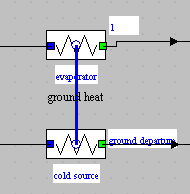Presentation of the exercise
This exercise shows how to model in Thermoptim a heat pump. This is an exercise built on a real case settled in England.
The heat pump for heating a nursery school uses the ground around the building as a cold source: heat is extracted from the ground by coils of plastic pipes.
We consider that you already know model a refrigeration cycle with Thermoptim. If this is not the case, start by studying session S31En.
Once the model set and the exergy balance established, heat exchangers are designed and the evaporator sized, to show how to do it in practice: its surface is calculated based on an estimate of the internal heat exchange coefficients
All these calculations are relatively complicated and imply to take certain precautions. If you are not familiar with the construction of heat exchangers in Thermoptim, you should refer to session S18En that specifically addresses this issue
(Session realized on 06/16/11 by Renaud Gicquel)Problem statement
- Nursery heat pump, ground cold source
- 30% volume polypropylene -glycol
- T ground: departure 0 °C – return 7 °C
- T heating: departure 44 °C – return 35 °C
- Heating capacity 35 kW (Tout = 5 °C)
- Refrigerant: propane
- Compressor isentropic efficiency: 0.85
- Model the plant
- Size the evaporator
- Set up the exergy balance
Cycle without exchangers

Construction of the exchanger


Heat exchanger screen

Heat exchanger screen

Heat pump diagram

Simple cycle exergy balance

Overall exergy balance
- Exergy efficiency = exergy transferred to the heating circuit (3.9 kW) divided by exergy received (8.17 kW)

Boiler exergy balance

Evaporator sizing
- Copper co-axial evaporator
- Inside diameter: 16 mm
- Spacing between tubes : 4 mm
- Refrigerant flowing inside

Summary
Starting from a realistic case study of a ground water heat pump, this exercise has shown how to conduct exergy balances, and you have become familiar with the calculation of heat exchangers in Thermoptim, and even sized the surface of one of them.
You will find in the archive that can be downloaded from the link below all work files used during this exercise, especially the project and diagram files of the heat pump and boiler models whose exergy efficiencies are compared.
In Thermoptim version 1.5, the calculation of heat transfer coefficients must be done by hand, outside the package. A version capable of technological design is being developed (version 1.7). It also allows one to study the off-design operation of various systems.
The values used to calculate heat transfer coefficients are approximate, both because the evaporator is actually a two-zone heat exchanger due to the presence of superheating, and because the correlations giving the Nusselt number are of limited accuracy. Our goal is simply to give some indication on how U can be estimated, since a precise calculation would be much more complicated and in addition is beyond the scope of thermodynamics


